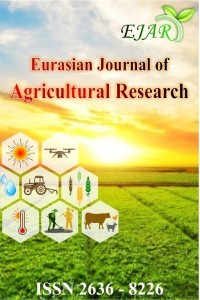A Review Article on Mineral Nutrition and Fertilizer Management of Cereal Crops
A Review Article on Mineral Nutrition and Fertilizer Management of Cereal Crops
This article was conceptualized to provide the readers other options and easy access to review the basics aspects of plant nutrition and fertilizer management of cereal crops. This article provided a brief overview of the plant mineral nutrition and fertilizer management in cereal crops. The concept behind the 17 essential elements the macronutrients and the micronutrient needed by the cereal crops. The nutrient elements are absorbed by plants primarily in ionic form from the soil. Nutrients can be taken up and distributed equally in straw and grain of the cereal crops. Thus, soils must therefore be replenished with those nutrient elements in the form of fertilizers. To have a basis for fertilizer application, the fertility status of the soil must be determined. Once the soil test results indicate the need for supplemental fertilizer, one must know how to calculate the amount of fertilizer needed and select the right one to avoid wastage and minimize costs. It needs to familiarize the fertilizer recommendation rate that will fit specific cereal crops and their ecosystems. Its cropping season, the effectiveness of the crop to use specific kind and availability of fertilizers in the market and financial resources of the farmer.
___
- AUSVEG (n.d.). Nutrient and physiological disorders. Retrieved from https://ausveg.com.au/biosecurity-agrichemical/crop-protection/nutrient-physiological- disorders/ Date accessed: March 28, 2019, 22:32.
- Biller, P., Lawson, D., Madsen, R.B., Becker, J., Iversen, B. B., and Glasius, M. (2017). Assessment of crops and natural vegetation in Scotland for energy production by anaerobic digestion and hydrothermal liquefaction. Biomass Conversion and Biorefinery. 7: 467. Retrieved from https://doi.org/10.1007/s13399-016-0230-x Date accessed: March 27, 2019, 16:40.
- Brady, N.C., and Weil, R.R. (1999). The Nature and Properties of Soils. 12th Edition, Prentice Hall Publishers, London.
- Bureau of Product Standards (2008). Philippine National Standard – Good agricultural practice for corn. Department of Trade and Industry, Metro Manila, Philippines.
- Buresh, R. J., R. Castillo, M. van den Berg and Gabinete, G. (n.d.). Nutrient management decision tool for small-scale rice and maize farmers. Food and Fertilizer Technology Center. Retrieved from http://www.fftc.agnet.org/library.php?func=view&id=20140305111316 Date accessed: March 27, 2019, 14:23.
- Buresh, R. J., M. F. Pampolino and Witt, C. (2010). Field-specific potassium and phosphorus balances and fertilizer requirement for irrigated rice-based cropping systems. Plant and Soil. 335: 35-64.
- Dobermann A., C. Witt, and D. Dawe (eds). 2004. Increasing the productivity of intensive rice systems through site-specific nutrient management. Science Publishers, Inc., Enfield, NH, USA and Int. Rice Res. Inst., Los Baños, Philippines.
- Hamissa, M. R., Keleg, A., M. S. Abdel-Aziz, A.Y. Gad, M.H. Taha, and Hamissa, A. L. (1997). The fertilizing value of the SCU and IBDU as N-carriers for paddy. Agric. Res. Rev. Min. of Agric. Cairo, 55: 143-155.
- Herrera, A. S. (2014). A SWOT analysis on conservation agriculture practices in Njombe, Tanzania. Master Thesis, Department of International Environment and Development Studies, Norwegian University of Life Sciences.
- Jeyakumar, P. and Balamohan, T. N. (n.d.). Diagnosis of nutritional disorders. They are retrieved from http://agritech.tnau.ac.in/agriculture/PDF/Diagnosis%20of%20nutritional%20disorders.p df Date accessed: March 28, 2019, 09:35.
- Maguire, R., Alley, M., and Flowers, W. (2009). Fertilizer types and calculating application rates. Virginia Cooperative Extension. Retrieved from www.ext.vt.edu Date: March 28, 2018, 23:40.
- Manna, A. B., and Singh, P. K. (1991). Effects of nitrogen fertilizer application methods on growth and acetylene reduction activity of Azolla pinnata and rice yield. Fertilizer Research 28: 25-30.
- Mattson, N. S. (2018). Plant mineral nutrition. In AccessScience. McGraw-Hill Education. https://doi.org/10.1036/1097-8542.523500 Date accessed: March 28, 2019, 21:42.
- NIOS (2012). Nutrition in Plants – Mineral Nutrition. National Institute of Open Schooling. Retrieved from https://nios.ac.in/media/documents/SrSec314NewE/Lesson-09.pdf Date accessed: March 25, 2019, 18:54.
- Roy, R. N., A. Finck, G. J. Blair and Tandon, H. L. S. (2006). Plant Nutrition for Food Security – a guide for integrated nutrient management. FAO Fertilizer and Plant Nutrition Bulletin. 16. Food and Agriculture Organization of the United Nations, Rome. ISBN 92-5-105490-8
- Schwenke, G. (2104). Nitrogen volatilization: factors affecting how much N is lost and how much is leftover time. Grains Research and Development Corporation. Retrieved from https://grdc.com.au/resources-and-publications/grdc-update-papers/tab-content/grdc-update-papers/2014/07/factors- affecting-how-much-n-is-lost-and-how-much-is-left-over-time Date: March 27, 2018, 13:44.
- Sela, G. (n.d.). Timing and frequency of fertilizer application. SMART Fertilizer Management. Retrieved from http://www.smart-fertilizer.com/articles/timing-fertilizer-application Date: March 27, 2018, 13:57.
- Xuan, V. T., and Ross, V. E. (1972). Training manual for rice production. The International Rice Research Institute. Yoshida, S. (1981). Fundamentals of rice crop science. Los Baños, Philippines, IRRI. 269 pp.
- ISSN: 2636-8226
- Yayın Aralığı: Yılda 2 Sayı
- Başlangıç: 2017
- Yayıncı: Muhammed Cüneyt BAĞDATLI
Sayıdaki Diğer Makaleler
A Review Article on Mineral Nutrition and Fertilizer Management of Cereal Crops
M. Cüneyt BAĞDATLI, Mohammad Aalim NAZARİ
The Assessment of Global Warming on Fish Production in Red Sea Region of Sudan
Wadah ELSHEİKH, İlknur UÇAK, M. Cüneyt BAĞDATLI
Impacts of Climate Change on Water Resources in Sudan
Wadah ELSHEİKH, Mohammed NASRELDİN
Evaluation of Climate Change on Agricultural Production in Afghanistan
Hamide ERSOY, Ebubekir ALTUNTAŞ
Agbai WİLLİAMS, Mouna KOSUOWEI
A Review on the Impact of Organic, Conventional and Nano Fertilizer Application in Crop Production
Je-ar COLİPANO, Ulysses CAGASAN
The Evaluation of Solid Waste Management Via Urbanization for Kirklareli Province (Turkey)
